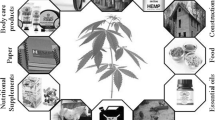Summary
Developed countries need to promote alternatives to crops produced in excess (such as cereals), and cultivation with limited environmental impact. Hemp (Cannabis sativa L.) is a potentially profitable crop, fitting into sustainable farming systems. Interest in “new” fibre crops is in fact increasing, to find alternatives to a high-input crop such as cotton, or to relieve the pressure of the paper industry on remaining natural forests. Besides, innovative applications are provided by hemp in renewable raw materials (oils from seeds and essential oils or secondary metabolites from inflorescences for food, cosmetic or pharmaceutical industry; straw and hurds for the building industry and for energy production). The development of more specialized hemp plants, needs a better understanding and control of metabolism. Since the renewed interest for this crop is increasing all over the world, it is important to update the knowledge on this crop, to understand whether it is a really sustainable, alternative and economically rewarding crop, and what contribution plant breeding, agronomical practice, and processing techniques are making, or could further make, to improve the relevant traits. The symposium “Hemp: perspectives for advanced utilization”, held in Bologna (Italy) on March 2004, was an opportunity to update the research carried out in different fields.
Similar content being viewed by others
References
Di Candilo M., P. Ranalli, C. Bozzi, B. Focher & G. Mastromei, 2000. Preliminary results of test facing with the controlled retting of hemp. Ind Crops Products 11: 197–203.
Di Candilo M., P. Ranalli, M. Diozzi & P. Zonda, 2000. Canapa da fibra: Modalità colturali a confronto. L’Informatore Agrario 16: 75–79.
Forapani S., A. Carboni, C. Paoletti, V.M.C. Moliterni, P. Ranalli & G. Mandolino, 2001. Comparison of Hemp Varieties Using Random Amplified Polymorphic DNA Markers. Crop Sci 42: 1682–1689.
Liberalato D., 2003. Prospect of hemp utilization in the European textile industry. Agroindustria 2/3: 147–148.
Mandolino G. & P. Ranalli, 2002. The applications of molecular markers in genetics and breeding of hemp. J Ind Hemp 7: 7–23.
Meijer E.P.M. de, M. Bagatta, A. Carboni, P. Crucitti, V.M.C. Moliterni, P. Ranalli & G. Mandolino, 2003. The inheritance of chemical phenotype in Cannabis sativa L. Genetics 163: 335–346.
Ranalli P., 1999. Advances in Hemp Research. The Haworth Press, Binghamton, New York (U.S.A.), 272 pp.
Ranalli P., M. Di Candilo, G. Mandolino, G. Grassi & A. Carboni, 1999. Hemp for sustainable agricultural systems. Agro-Food-Industry Hi-Tech. 2(10): 33–38.
Venturi G., 2004. Le colture da fibra: Alcune nuove destinazioni d’uso del prodotto. Agroindustria 1: 51–55.
Author information
Authors and Affiliations
Corresponding author
Rights and permissions
About this article
Cite this article
Ranalli, P., Venturi, G. Hemp as a raw material for industrial applications. Euphytica 140, 1–6 (2004). https://doi.org/10.1007/s10681-004-4749-8
Issue Date:
DOI: https://doi.org/10.1007/s10681-004-4749-8




